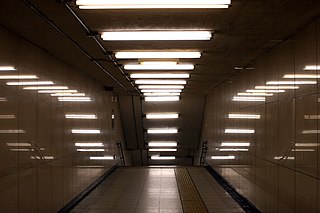
A fluorescent lamp, or fluorescent tube, is a low-pressure mercury-vapor gas-discharge lamp that uses fluorescence to produce visible light. An electric current in the gas excites mercury vapor, which produces short-wave ultraviolet light that then causes a phosphor coating on the inside of the lamp to glow. A fluorescent lamp converts electrical energy into useful light much more efficiently than an incandescent lamp. The typical luminous efficacy of fluorescent lighting systems is 50–100 lumens per watt, several times the efficacy of incandescent bulbs with comparable light output. For comparison, the luminous efficiency of an incandescent bulb may only be 16 lumens per watt.

Sentō (銭湯) is a type of Japanese communal bathhouse where customers pay for entrance. Traditionally these bathhouses have been quite utilitarian, with a tall barrier separating the sexes within one large room, a minimum of lined-up faucets on both sides, and a single large bath for the already washed bathers to sit in among others. Since the second half of the 20th century, these communal bathhouses have been decreasing in numbers as more and more Japanese residences now have baths. Some Japanese find social importance in going to public baths, out of the theory that physical proximity/intimacy brings emotional intimacy, which is termed skinship in pseudo-English Japanese. Others go to a sentō because they live in a small housing facility without a private bath or to enjoy bathing in a spacious room and to relax in saunas or jet baths that often accompany new or renovated sentōs.

A blacklight, also called a UV-A light, Wood's lamp, or ultraviolet light, is a lamp that emits long-wave (UV-A) ultraviolet light and very little visible light. One type of lamp has a violet filter material, either on the bulb or in a separate glass filter in the lamp housing, which blocks most visible light and allows through UV, so the lamp has a dim violet glow when operating. Blacklight lamps which have this filter have a lighting industry designation that includes the letters "BLB". This stands for "blacklight blue". A second type of lamp produces ultraviolet but does not have the filter material, so it produces more visible light and has a blue color when operating. These tubes are made for use in "bug zapper" insect traps, and are identified by the industry designation "BL". This stands for "blacklight".

Sun tanning or tanning is the process whereby skin color is darkened or tanned. It is most often a result of exposure to ultraviolet (UV) radiation from sunlight or from artificial sources, such as a tanning lamp found in indoor tanning beds. People who deliberately tan their skin by exposure to the sun engage in a passive recreational activity of sun bathing. Some people use chemical products that can produce a tanning effect without exposure to ultraviolet radiation, known as sunless tanning.

Indoor tanning involves using a device that emits ultraviolet radiation to produce a cosmetic tan. Typically found in tanning salons, gyms, spas, hotels, and sporting facilities, and less often in private residences, the most common device is a horizontal tanning bed, also known as a sunbed or solarium. Vertical devices are known as tanning booths or stand-up sunbeds.
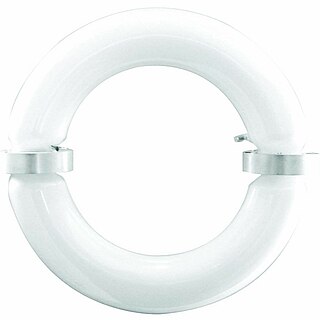
The induction lamp, electrodeless lamp, or electrodeless induction lamp is a gas-discharge lamp in which an electric or magnetic field transfers the power required to generate light from outside the lamp envelope to the gas inside. This is in contrast to a typical gas discharge lamp that uses internal electrodes connected to the power supply by conductors that pass through the lamp envelope. Eliminating the internal electrodes provides two advantages:

A deckchair is a folding chair, usually with a frame of treated wood or other material. The term now usually denotes a portable folding chair, with a single strip of fabric or vinyl forming the backrest and seat. It is meant for leisure, originally on the deck of an ocean liner or cruise ship. It is easily transportable and stackable, although some styles are notoriously difficult to fold and unfold. Different versions may have an extended seat, meant to be used as a leg rest, whose height may be adjustable; and may also have arm rests.

A bath chair—or Bath chair—was a rolling chaise or light carriage for one person with a folding hood, which could be open or closed. Used especially by disabled persons, it was mounted on three or four wheels and drawn or pushed by hand. It is so named from its origin in Bath, England.

A test light, test lamp, voltage tester, or mains tester is a piece of electronic test equipment used to determine the presence of electricity in a piece of equipment under test. A test light is simpler and less costly than a measuring instrument such as a multimeter, and often suffices for checking for the presence of voltage on a conductor. Properly designed test lights include features to protect the user from accidental electric shock. Non-contact test lights can detect voltage on insulated conductors.

Tanning lamps are the part of a tanning bed, booth or other tanning device which produces ultraviolet light used for indoor tanning. There are hundreds of different kinds of tanning lamps most of which can be classified in two basic groups: low pressure and high pressure. Within the industry, it is common to call high-pressure units "bulbs" and low-pressure units "lamps", although there are many exceptions and not everyone follows this example. This is likely due to the size of the unit, rather than the type. Both types require an oxygen free environment inside the lamp.

The set of large ornate staircases in the first-class section of the Titanic, and RMS Olympic ; sometimes collectively referred to as the Grand Staircase, is one of the most recognizable features of the British transatlantic ocean liner which sank on her maiden voyage in 1912 after a collision with an iceberg. Reflecting and reinforcing the staircase's iconic status is its frequent, and prominent, portrayal in media.

The Olympic-class ocean liners were a trio of British ocean liners built by the Harland & Wolff shipyard for the White Star Line during the early 20th century. They were Olympic (1911), Titanic (1912) and Britannic (1914). All three were designed to be the largest and most luxurious passenger ships at that time, designed to give White Star an advantage in the transatlantic passenger trade.
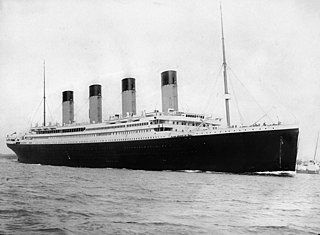
RMS Titanic was a British ocean liner that sank on 15 April 1912 as a result of striking an iceberg on her maiden voyage from Southampton, England to New York City, United States. Of the estimated 2,224 passengers and crew aboard, 1,496 died, making the incident the deadliest sinking of a single ship at the time. Titanic, operated by the White Star Line, carried some of the wealthiest people in the world, as well as hundreds of emigrants from the British Isles, Scandinavia, and elsewhere in Europe who were seeking a new life in the United States and Canada. The disaster drew public attention, spurred major changes in maritime safety regulations, and inspired a lasting legacy in popular culture.

The "Big Four" were a quartet of early-20th-century 20,000-ton ocean liners built by the Harland & Wolff shipyard for the White Star Line, to be the largest and most luxurious ships afloat. The group consisted of Celtic, Cedric, Baltic and Adriatic.

A wheelchair is a mobilized form of chair using 2 or more wheels, a footrest and armrest usually cushioned. It is used when walking is difficult or impossible to do due to illnesses, injury, disabilities, or age related health conditions.
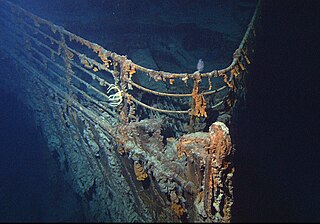
The wreck of the Titanic lies at a depth of about 12,500 feet, about 370 nautical miles south-southeast off the coast of Newfoundland. It lies in two main pieces about 2,000 feet (600 m) apart. The bow is still recognisable with many preserved interiors, despite deterioration and damage sustained hitting the sea floor. In contrast, the stern is heavily damaged. A debris field around the wreck contains hundreds of thousands of items spilled from the ship as she sank. The bodies of the passengers and crew would also be distributed across the seabed, but have since been consumed by other organisms.

Reflecting the White Star Line's reputation for superior comfort and luxury, the Titanic had extensive facilities for First Class passengers which were widely regarded as the finest of her time. In contrast to her French and German competitors, whose interiors were extravagantly decorated and heavily adorned, the Titanic emphasized comfort and subdued elegance more in the style of a British country manor or luxury hotel. Titanic's enormous size enabled her to feature unusually large rooms, all equipped with the latest technologies for comfort, hygiene, and convenience. Staterooms and public spaces recreated historic styles with a painstaking attention to detail and accuracy. There was a wide range of recreational and sporting facilities in addition which provided ample opportunity for amusement during a voyage.
Second-class accommodation and facilities on board the Titanic were quite intricate and spacious in comparison to many first-class facilities on other ships of the time. Although the Second and Third Class sections of the ship occupied a much smaller proportion of space overall than those of first class aboard the Titanic, there were several comfortable, large public rooms and elevators for the passengers to enjoy, so much in fact that the minority of the spaces provided were actually used during the voyage. 284 passengers boarded Second Class in a ship that could accommodate 410 second-class passengers.
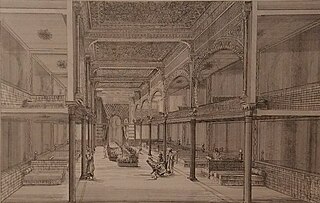
The Victorian Turkish bath is a type of bath in which the bather sweats freely in hot dry air, is then washed, often massaged, and has a cold wash or shower. It can also mean, especially when used in the plural, an establishment where such a bath is available.


















